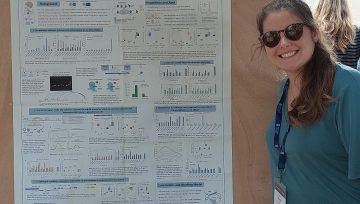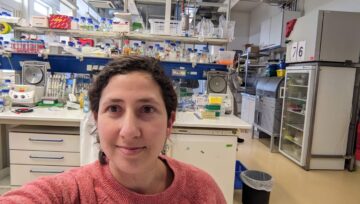The recipient of the Article of the Month for August 2024 is Tal Rafael Ben-David from the lab of Prof. Phillippa Melamed, whose article has been accepted for publication in Cellular and Molecular Life Sciences. To celebrate this exciting achievement, we asked Tal to share some interesting details about her research in the lab, the current paper, and about herself.
- Hi Tal. For those who aren’t familiar with you, please introduce yourself in a sentence.
My name is Tal. I grew up in Kfar Saba and, in recent years, lived with my family in Haifa. I completed a bachelor’s degree in Biochemical Engineering at the Technion, followed by a master’s and Ph.D. in the Faculty of Biology in Prof. Phillippa Melamed’s lab.
- What does the Melamed lab focus on in general?
In Prof. Phillippa Melamed’s lab, we study endocrinology and epigenetics of the reproductive system. We are fascinated by hormones, which act as messengers in the body and impact many processes, including growth, mood, reproduction, and more. We investigate the genes responsible for expressing these hormones and seek to understand in-depth the molecular mechanisms that regulate and activate them. One of the hormones studied in our lab is LH (Luteinizing Hormone), which plays a central role in the reproductive system by helping to regulate the development and function of reproductive organs (testes and ovaries). - Tell us about the current article. What was the research goal, and what did you discover?
In our latest research, we aimed to understand how the body regulates the levels of the gene that encodes LH production. Why is this important? LH levels vary during puberty, the menstrual cycle, and menopause. It is essential to maintain balanced and regulated levels of this hormone, as deviations—too much or too little—can lead to health issues.
During our research, we discovered a small “switch” located in the DNA, far from the gene responsible for LH production, which helps activate and deactivate this gene and plays a central role in controlling its levels. This “switch” is not a typical DNA sequence, but a unique structure called “i-motif,” which functions as a regulator—we found that it can bind a specific protein, directing the transcription of a regulatory RNA to help maintain balanced levels of the gene that encodes for the LH.
Our research revealed that this switch is part of a system of non-coding elements located in the DNA, far from the gene, that ensures balanced gene levels. We also found that long non-coding RNA is transcribed from a region near the “switch,” which its transcription and editing further amplifies and maximizes the gene’s production levels.
One of the fascinating findings was that this mechanism operates differently in female mice than in males, suggesting that specific genes in the reproductive system may have gender-specific regulatory mechanisms.
- Can you explain the significance behind the discovery? What directions/applications does it open up? How do you see this research impacting the field in the coming years?
The significance of this discovery lies in understanding the complex regulatory mechanisms that enable essential reproductive genes to function in a controlled and precise manner. Understanding these mechanisms opens possibilities for developing medical applications, such as treatments for hormonal disorders resulting from hormonal imbalances. Additionally, the discovery of the i-motif switch, which influences the Lhb gene and the understanding that this regulatory system operates differently in females and males, is a significant step, offering new insights into gene regulation differences in the reproductive system between genders, potentially leading to a deeper understanding of gender-specific gene regulation and personalized medicine in the future. - Was there a particularly challenging moment in your research, and how did you handle it?
It’s safe to say that many experiments have small, challenging moments. Anyone conducting research can probably relate to the feeling of at least once a week having an experiment not go as planned, which can make it feel like the entire study has gone astray. But from such moments, every researcher learns to rise and find motivation for the next experiment 🙂 - Was there any unique/unexpected discovery during the research that wasn’t part of the original plan?
The unique discovery in our research was the study of regulatory DNA structures that can function as “switches,” known as i-motif/g-quadruplex, and realizing that these structures have significant importance in the regulatory mechanism of the Lhb gene, playing a central role in its expression in the reproductive axis. At the beginning of the research, we did not anticipate arriving at this direction, and we were surprised and excited to delve into this fascinating field. - List three key skills you gained in the lab during your work and studies.
Independent, critical, and creative thinking; optimal time management; and the ability to manage a scientific research project from start to finish. - How do you manage to balance your research with personal life, and which hobbies or activities help you maintain that balance?
When I’m not busy with research, I spend time with my wonderful family—my daughter Mika and my husband Itay. When I find time for hobbies, I love baking (especially bread), doing sports, and traveling with my family. - What are your career aspirations?
My aspiration is to join the biotech/pharma industry, and I am currently looking for the next role and challenge where I can integrate and grow. I believe I have a lot to contribute from the extensive experience I gained in research.
⬅ Link to the article: link.springer.com/article/10.1007/s00018-024-05398-7
⬅ Link to Prof. Melamed’s page: https://biology.technion.ac.il/en/member/melamed/
⬅ Link to the Melamed Lab site: mol-endo.net.technion.ac.il














